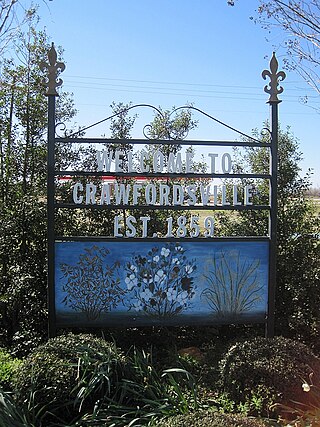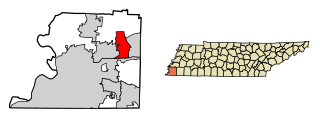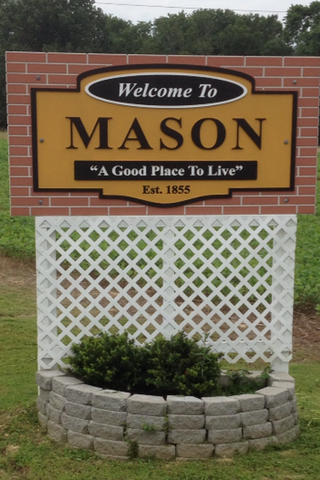
Fayette County is a county located in the U.S. state of Tennessee. As of the 2020 census, the population was 41,990. Its county seat is Somerville. The county was named after the Marquis de la Fayette, French hero of the American Revolution. A part of the Memphis, TN-MS-AR Metropolitan Statistical Area, Fayette County is culturally alike to the Mississippi Delta and was a major area of cotton plantations dependent on slave labor in the nineteenth century.

Crawfordsville, historically Crawfordville, is a town in Crittenden County, Arkansas, United States. The population was 479 at the 2010 census.

Hickory Flat is a town in Benton County, Mississippi, United States. The population was 601 at the 2010 census.

Valdese is a town in Burke County, North Carolina, United States. The population was 4,689 at the 2020 census. It is part of the Hickory-Lenoir-Morganton Metropolitan Statistical Area. One of the largest Waldensian congregations in the United States was founded in the town in the late nineteenth century, now known as the Waldensian Presbyterian Church. The town was settled by immigrants from the Cottian Alps in the Piedmont region of Italy.
Hopewell is a census-designated place (CDP) and unincorporated community in Bradley County, Tennessee, United States. The population was 2,087 at the 2020 Census. It is included in the Cleveland, Tennessee Metropolitan Statistical Area.

Alamo is a town in Crockett County, Tennessee, United States. Its population was 2,461 at the time of the 2010 U.S. Census. Alamo, located in the central part of West Tennessee, is the county seat of Crockett County.

Gallaway is a city in Fayette County, Tennessee, United States. The population was 680 at the 2010 census.

Rossville is a town in Fayette County, Tennessee, United States. The population was 1,041 at the 2020 census, up from 664 at the 2010 census.

Somerville is a town in Fayette County, Tennessee, United States. It is part of the Memphis metropolitan area. The population was 3,415 at the 2020 census, up from 3,094 at the 2010 census. It is the county seat of Fayette County.

Hickory Valley is a town in Hardeman County, Tennessee, United States. The population was 99 at the 2010 census. Hickory Valley's origin dates back to the blending of three independent pioneer settlements in the area that were founded by three men: William Shinault in 1820, Drury Wood in 1826 and William Barnett in 1827.

Whiteville is a town in Hardeman County, Tennessee, United States. The population was 2,606 at the 2020 census and 4,638 at the 2010 census, Whiteville is the location of two privately owned prisons, Whiteville Correctional Facility and Hardeman County Correctional Center.

Stanton is a town in Haywood County, Tennessee. The population was 615 as of the 2000 census and 452 at the 2010 census, showing a population decrease of 163.

Ripley is a city in Lauderdale County, Tennessee, United States. The population was 8,445 at the 2010 census. It is the county seat of Lauderdale County.

Bethel Springs is a town in McNairy County, Tennessee. The population was 998 at the 2020 census.

Helenwood is an unincorporated community in Scott County, Tennessee, United States. The population was 846 at the 2000 census, when Helenwood was treated as an incorporated municipality. For the 2010 census, it was a census-designated place (CDP) with a population of 865.

Arlington is a town in Shelby County, Tennessee, United States. The population was 2,569 at the 2000 census, 11,517 at the 2010 census, and 14,549 at the 2020 Census. From 2010 until 2020 the town's population grew by 26.326%. It is one of the seven municipalities in Shelby County. The town lies wholly within the borders of Shelby County.

Germantown is a city in Shelby County, Tennessee, United States. The population was 41,333 at the 2020 census.

Lakeland is a city in Shelby County, Tennessee, United States, and a part of the Memphis metropolitan area. The population was 12,430 at the 2010 census.

Brighton is a town in Tipton County, Tennessee, United States. The population was 2,735 at the 2010 census.

Mason is a town in Tipton County, Tennessee. The population was 1,609 at the 2010 census. Mason is located along U.S. Route 70, and is home to a federal detention facility.




















